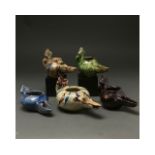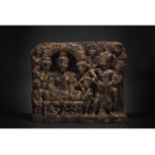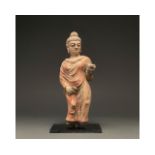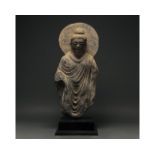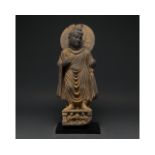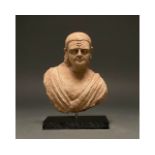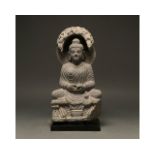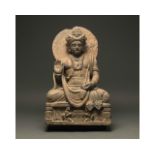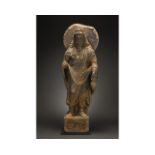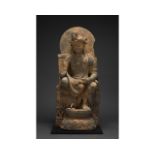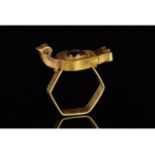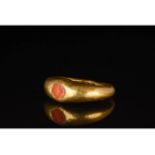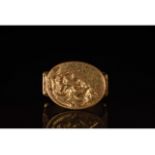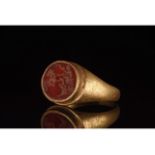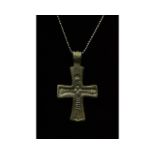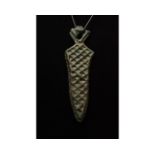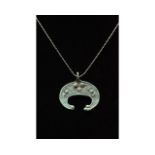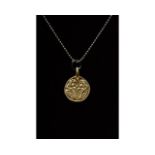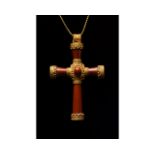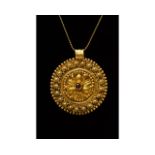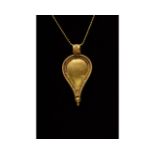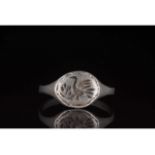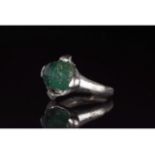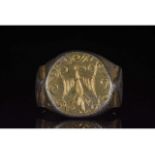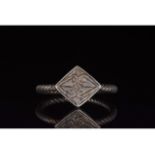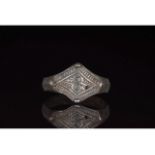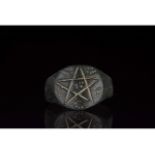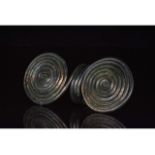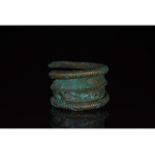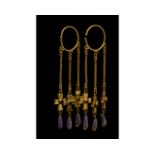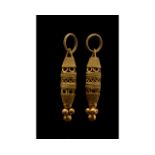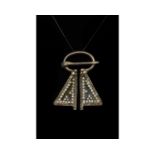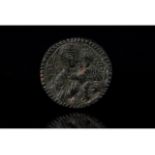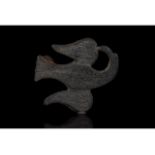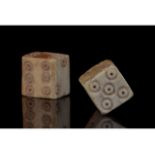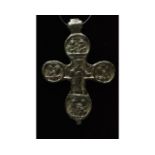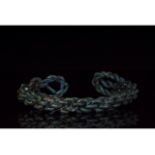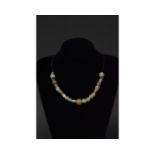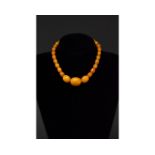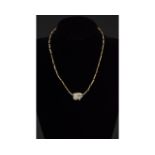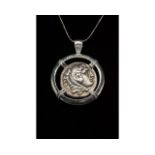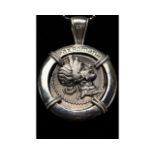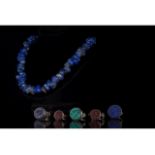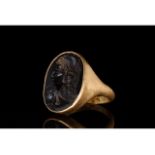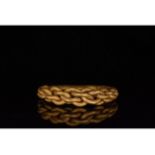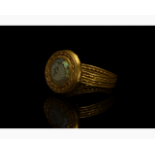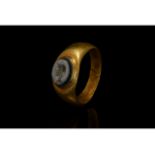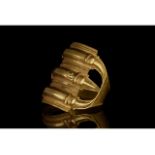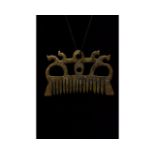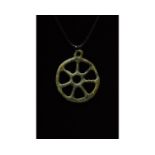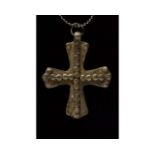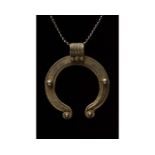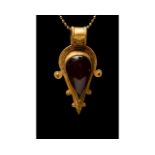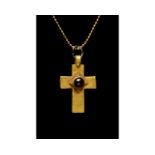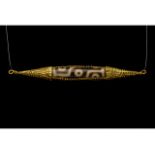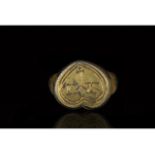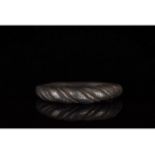Refine your search
Estimate
Category
- Arms, Armour & Militaria (180)
- Jewellery (118)
- Greek, Roman, Egyptian & Other Antiquities (86)
- Chinese Works of Art (55)
- Scientific Instruments (33)
- Sculpture (24)
- Collectables (20)
- Coins (19)
- Ceramics (13)
- Salvage & Architectural Antiques (8)
- Vintage Fashion (8)
- Glassware (7)
- Bank notes (6)
- Islamic Works of Art (6)
- Metalware (6)
- Books & Periodicals (5)
- Models, Toys, Dolls & Games (3)
- Textiles (3)
- Classic Cars, Motorcycles & Automobilia (2)
- Musical Instruments & Memorabilia (2)
- Wines & Spirits (2)
- Clocks (1)
- Kitchenalia (1)
- Silver & Silver-plated items (1)
Filtered by:
- Item Type
- List
- Grid
A subscription to the Price Guide is required to view results for auctions ten days or older. Click here for more information
ca. 1100 AD. Seljuk. This lot of beautiful medieval Islamic period glazed lamps were probably made under the Seljuk dynasty. Five lamps with a glo...
100-300 AD. Gandharan. An amazing large Gandhara panel made of red schist with a scene from the life of Buddha. The Buddha is placed at the center...
GANDARA STUCCO FIGURE OF BUDDHA
300–500 AD. Gandharan. This striking Gandharan stucco figure of a standing Buddha is executed in a highly stylised manner, with a severe face, h...
100-300 AD. Gandharan. A grey schist torso of Buddha with a painted topknot (ushnisha), urna on the forehead, arched brow, heavily lidded, closed ...
100-300 AD. Gandharan. A grey schist figure of standing Buddha. He is depicted wearing a flowing gown and sporting a topknot (ushnisha). He has ur...
300-500 AD. Gandharan. A pale orange stucco bust of a male ascetic, depicted in the idealised manner typical of Gandharan art. He is depicted rest...
100-300 AD. Gandharan. A grey schist figure of a seated Buddha. He is depicted wearing a flowing robe and a topknot (ushnisha). There is an urna o...
100-300 AD. Gandharan. Schist figure of a bodhisattva, backed by a halo, who sits, gazing serenely into the distance. He is dressed in an elegant ...
100-300 AD. Gandharan. A giant schist figure of a bodhisattva, backed by a halo, who stands, gazing serenely into the distance. He is dressed in a...
100-300 AD. Gandharan. A giant schist figure of a bodhisattva, backed by a halo, who sits, gazing serenely into the distance. He is dressed in an ...
600-900 AD. Byzantine. A rare medieval gold ring with a hexagonal hoop and zoomorphic bezel in the form of a bird in flight; the bird’s back is ...
100-300 AD. Roman. A stunning gold wing with a thick, circular hoop and rounded red stone intaglio setting engraved with a bee in flight. Bees wer...
c. 323-31 BC. Greek Hellenistic period. A rare gold ring with a D-shaped hoop, scalloped shoulders and elliptical plate bezel bearing an engraved ...
C. 100-300 AD. Roman. A gold ring with a circular hoop and round red gemstone intaglio depicting the god Apollo in a chariot pulled by a pair of p...
1000-1500 AD, Crusader Period. Bronze cross pendant with a circular ribbed suspension loop, tapering arms and a stylised, abstract depiction of Je...
Ca. 700-1100 AD. Viking Age. A bronze pendant in the shape of sword comprising an openwork triangular pommel, short handle lozenge-shaped blade wi...
C. 900-1100 AD. Viking Period. Bronze lunar pendant a crescent moon with raised circular and geometric decorations and a small suspension loop. Th...
C. 700-1100. Viking Age. Silver gilt amulet featuring a disc shape with an integral suspension loop. The central section depicts the god Odin grip...
1100-1300 AD. Byzantine. Stunning gold cross with rounded, ribbed suspension loop, gold terminals and crosspiece with elaborate filigree decoratio...
c. 323-31 BC. Greek Hellenistic period. A gold pendant with a rounded, ribbed suspension loop, and disk-shaped body featuring concentric reliefs w...
ROMAN GOLD PENDANT
C. 100-300 AD, Roman. A beautiful gold pendant comprising an inverse tear-drop shaped charm with an integrated suspension loop, applied granulatio...
700-1100 AD, Viking Age. Beautiful silver ring comprised of a D-shaped hoop and a circular bezel bearing incised decoration in the form of a beast...
700-1100 AD, Viking Age. Silver ring with a circular hoop, and a lozenge shaped bezel onto which is mounted a large, circular green gem. This simp...
C. 1100-1300 AD. Byzantine. A large silver gilt ring with a circular hoop, heavy band featuring lozenge-shaped decoration on the shoulders and a c...
MEDIEVAL SILVER DECORATED RING
C. 700-1100 AD, Viking Age. A silver ring with a twisted circular hoop and a lozenge-shaped bezel with incised linear and curvilinear decorations,...
C. 700-1100 AD, Viking Age. A silver ring with a circular hoop and a lozenge-shaped bezel with incised linear and curvilinear decorations, possibl...
ROMAN BRONZE RING WITH PENTAGRAM
1-200 AD. Roman. Heavy bronze ring with a circular hoop and flattened, rounded bezel bearing an incisded pentagram and dots. For more information ...
BEAUTIFUL BRONZE AGE COILED RING
Ca.800 BC, Bronze Age. A beautiful Celtic bronze ring comprising a coiled wire which forms a circular hoop in the rear and two large circular proj...
VIKING BRONZE COILED SNAKE RING
700-1100 AD, Viking Age. A bronze coiled ring with ttwisted railing ends and lozenge-shaped central plate bearing a line of applied granulations, ...
1100-1300 AD. Byzantine. A stunning pair of gold earrings, each comprising a hoop with three composite pendants made up of a cord woven from gold ...
ROMAN GOLD FILIGREE EARRINGS
C. 300-500 AD, Late Roman. Intricate gold pendant earrings comprising suspension loops supporting biconical openwork filigree charms decorated wit...
Ca. 900-1100 AD. Viking Era. A late Viking era silver pannanular omega brooch with flaring terminals decorated with raised dots arranged in geomet...
C. 1000-1500 AD. Crusaders period. A bronze, disk-shaped medallion with scalloped edges depicting the Virgin Mary holding an infant Jesus in an ab...
C. 100-200 AD, Roman. Silver brooch in the shape of a stylised eagle and a well preserved catchplate. This motif is probably a precursor to the do...
PAIR OF ROMAN BONE DICE
100-200 AD. Roman. A set of two bone dice with carefully carved dot-in-circle pips which are typical of dice of the Roman period. Games involving ...
1000-1500 AD, Crusader Period. A large bronze cross pendant with suspension loop and rounded arms; the cross bears extensive relief decoration on ...
VIKING TWISTED BRONZE BRACELET
700-1100 AD, Viking Age. A heavy bronze twisted bracelet comprising several strands of bronze woven together with loop terminals. In Norse mytholo...
C. 1000–600 BC, Bronze Age. A heavy bronze bracelet with a flaring, ribbed midsection and coiled, spiral terminals. In the Bronze Age bracelets ...
Ca. 100-300 AD. Roman. A restrung necklace of Roman beads comprising multiple opaque and transparent sub- spherical, tubular and rectangular glass...
C. 1800-1900 AD. Baltic amber bead necklace comprising subspherical beads of varying sizes. The beads have been professionally restrung. Amber fro...
712-30 BC, Late Period/Ptolemaic. A beautiful restrung necklace with creme coloured tubular faience beads and dark coloured discoid faience beads ...
C. 295-275 BC. Hellenistic Period. A silver coin / drachm of Alexander the Great within a modern handmade circular sterling silver setting made ex...
C. 50-44 BC. Late Roman Republic period. A silver denarius coin of Julius Caesar within a modern handmade circular sterling silver setting made ex...
Ca.1700-1950 AD. Yemeni Tribal. Lot of five white metal Yemeni Tribal intaglio rings with turquoise, blue and red coloured stone itaglio settings ...
c. 100-300 AD. Roman. A rare gold ring with a circular hoop and elliptical bezel with a red hardstone setting engraved with a highly naturalistic ...
c. 900-1100 AD. Viking Age. Twisted gold ring comprising of circular hoop comprised of interwoven strands of gold. This ring was intended to evoke...
CA. 600 AD; GOLD BYZANTINE RING WITH GLASS COBOCHON. In order to confirm its authenticity, this piece has undergone X-Ray Fluorescence analysis by...
CA. 100 AD. ROMAN GOLD INTAGLIO RING WITH NICOLO PORTRAIT STONE. In order to confirm its authenticity, this piece has undergone X-Ray Fluorescence...
100-300 AD, Roman. A rare gold ring with a circular hoop and elliptical trumpet bezel with red gemstone intaglio bearing an erotic scene comprisin...
c. 700 AD. Viking Age. Gold ring comprising a circular hoop with ribbed shoulders and a double plate bezel. The bezel plates, which are slightly c...
700-1100 AD, Viking Age. A bronze pendant comprising a stylised openwork dragon-shaped handle on the upper part and below it a comb with long, poi...
BRONZE AGE WHEEL PENDANT
Ca. 600 BC. Bronze Age. Bronze age wheel pendant comprising circular hoop and crossed spokes. In ancient societies, wheel amulets were traditional...
1000-1500 AD, Crusader Period. Beautiful silver cross pendant with suspension loop and rounded arms; the cross bears extensive relief decoration, ...
ROMAN SILVER LUNAR PENDANT
Ca. 100 AD, Roman. Silver lunar amulet comprising a crescent moon with applied silver baubles and a wide banded suspension loop. In Roman mytholog...
ROMAN GOLD AND GARNET PENDANT
100-300 AD, Roman. A gorgeous inverted teardrop-shaped gold pendant with an integral suspension loop and garnet cabochon setting. The edges of the...
1000-1500 AD, Crusader Period. A beautiful gold pendant in the form of a Latin cross, with a central garnet cabochon flanked by applied baubles; t...
c. 323-31 BC. Greek Hellenistic period. A gold pendant bead with dual suspension loops, conical terminals and cylindrical body. The pendant is dec...
1100-1300 AD. Medieval. A silver gilt ring with a round hoop and heart-shaped plate bezel bearing an double concentric heart border and a monogram...
VIKING SILVER TWISTED RING
c. 900-1100 AD. Viking Age. Twisted silver ring comprising of circular hoop comprised of interwoven strands of silver which were melded into a sin...
Ca. 1200 AD, Medieval. A silver archer’s ring comprising a circular hoop and projecting triangular guard. The exterior of the hoop and guard are...

